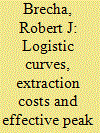| Srl | Item |
| 1 |
ID:
093525


|
|
|
|
|
| Publication |
2010.
|
| Summary/Abstract |
More than 20 countries in the world have already reached a maximum capacity in their coal production (peak coal production) such as Japan, the United Kingdom and Germany. China, home to the third largest coal reserves in the world, is the world's largest coal producer and consumer, making it part of the Big Six. At present, however, China's coal production has not yet reached its peak. In this article, logistic curves and gaussian curves are used to predict China's coal peak and the results show that it will be between the late 2020s and the early 2030s. Based on the predictions of coal production and consumption, China's net coal import could be estimated for coming years. This article also analyzes the impact of China's net coal import on the international coal market, especially the Asian market, and on China's economic development and energy security.
|
|
|
|
|
|
|
|
|
|
|
|
|
|
|
|
| 2 |
ID:
116977


|
|
|
|
|
| Publication |
2012.
|
| Summary/Abstract |
Debates about the possibility of a near-term maximum in world oil production have become increasingly prominent over the past decade, with the focus often being on the quantification of geologically available and technologically recoverable amounts of oil in the ground. Economically, the important parameter is not a physical limit to resources in the ground, but whether market price signals and costs of extraction will indicate the efficiency of extracting conventional or nonconventional resources as opposed to making substitutions over time for other fuels and technologies. We present a hybrid approach to the peak-oil question with two models in which the use of logistic curves for cumulative production are supplemented with data on projected extraction costs and historical rates of capacity increase. While not denying the presence of large quantities of oil in the ground, even with foresight, rates of production of new nonconventional resources are unlikely to be sufficient to make up for declines in availability of conventional oil. Furthermore we show how the logistic-curve approach helps to naturally explain high oil prices even when there are significant quantities of low-cost oil yet to be extracted.
|
|
|
|
|
|
|
|
|
|
|
|
|
|
|
|